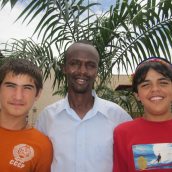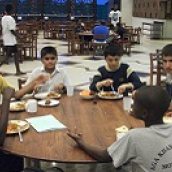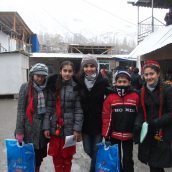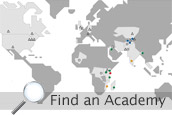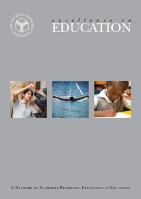International Student Exchange at the Academy
As the international network of Aga Khan Academies gradually expands, administrators hope similar cross-cultural insights can be gained by students elsewhere in the developing world. This programme may soon broaden to South Asia, where the Aga Khan Academy in Hyderabad, India hopes to receive a handful of outstanding young students from Afghanistan starting in 2014. Slowly but surely, the programme is laying a foundation for the future, when students and faculty across the growing network of Aga Khan Academies will be able to collaborate and travel between different campuses on different continents, sharing not just culture but also knowledge, ideas and best practices.
If all goes according to plan, tomorrow’s leaders, such as the Tajik pupils now studying in Mombasa, will be in a unique position to return to their home countries and make well-informed contributions to social and economic progress. “Many of the Tajik students are saying that they ultimately want to go back and do something for their communities,” says Aziz Batada, a former Aga Khan Academy, Mombasa biology instructor who manages the programme. Perhaps one day the students will even return to East Africa as diplomats, or as business leaders seeking to strengthen trade relations.
According to Batada, the programme has been very successful so far. Academically, the Tajik students are performing at or above their class average. Some of them have even achieved honours, earning high marks in nine required subjects: math, science, literature, technology, humanities, physical education, expressive arts, Kiswahili and Russian (which the students study instead of French because of its prevalence in Central Asia). “This is fantastic because all of those subjects, aside from the language requirements, are completed in English, which is probably their third or fourth language,” says Batada.
Outside of the classroom, the Tajik students participate in extracurricular activities like basketball, rugby, theatre and Model United Nations. They are demonstrating confidence socially, too, and are often seen having meals, conversing or watching movies with non-Tajik friends and roommates. While Dorm Parents like Ogega have noticed a tendency for the Tajik students to stick together initially, this seems natural and recedes as time passes. As Batada notes: “They shift back and forth, but that connection between them will always be there.”
Ganjina Vanjova, 14, is one of the Tajik students currently studying in Mombasa. She was part of the very first cohort of eight Tajik students who arrived at the Academy in 2011. (A second cohort of four students arrived the following year, and a third cohort of four students has been selected and will arrive this year.) Because of how the programme is structured, she joined the Academy halfway through grade 6; this format enables the students to ease into their new environment while receiving dedicated support and instruction through a special orientation process. Now in grade 8, Ganjina says she is grateful for this once-in-a-lifetime opportunity. She says the Academy has helped her think critically and creatively, especially when it comes to reading literature: “We go very deep into the meanings of any short stories or novels, and I particularly enjoy discovering symbolism and other devices. Back at home we used to read a story and retell it, which didn’t really teach us how deep a language can be.”
The residential environment, too, has been a source of personal growth for Ganjina. “Residence life teaches you to live independently and to value your time, the money of your parents and your parents themselves,” she says. Parents of the Tajik students miss their children, but are confident that the programme is giving them a world-class education with an international emphasis. “The Academy will give modern and required knowledge to our son,” says Alibekov Mirzonabod, whose son Abror is in grade 7. “We trust the Aga Khan Academy and are not worrying for the safety of our child.”Parents also say the experience is helping their children mature into responsible young adults. Every night before she goes to sleep, Iskandarshoeva Zubayda says she thinks about her daughter, grade 8 student Zuhal, but is proud of Zuhal’s independence, courage and success. “Life in the Academy influenced her character, behaviour, habits and even her view to life,” Zubayda says. “She became very punctual, well-organised and very responsible.” Already, Zuhal is making a difference in her home community: “Every summer when she comes back from the Academy she is always doing volunteer work—teaching English for the kids,” her mother says.
The programme has encountered various challenges in its three-year history, however, resulting in some changes to how the programme is run and students are selected. The biggest hurdle involves making the programme sustainable so that it can grow to encompass other campuses and communities. For example, the first cohort of Tajik students was selected by members of the Academy’s admissions committee, who travelled all the way from Mombasa to Khorog, Tajikistan, where all of the programme’s candidates have come from so far. (The programme will soon widen to other parts of Tajikistan including its capital, Dushanbe).The trip was expensive and time-consuming, so for the second cohort, the admissions committee set up a “national nomination committee” based in Khorog and comprised of local professionals. Volunteering their time, these professionals (who mainly had backgrounds in education) conducted interviews and evaluated candidates, applying the same innovative assessment tools as before. After receiving a shortlist from the national nomination committee, as well as digital recordings of one-on-one interviews and other key documentation, the admissions committee made the final decisions without ever having to leave Mombasa.
Meanwhile, administrators are trying to allocate financial aid in a way that allows students from places like Tajikistan and Afghanistan to attend an Aga Khan Academy, while at the same time ensuring that financial resources are not diverted away from deserving students in the countries where Academies are located. Administrators want each Academy’s national character to remain intact, and are committed to providing financial aid to meritorious local students without the means to attend.
Another challenge has been putting the right support systems in place so that the Tajik students can excel at the Academy and beyond. During the orientation process they undergo when they first arrive, the Academy is increasingly emphasising English language skills and critical thinking, two areas where faculty members have noticed room for improvement. The Academy also seeks to provide cultural support by employing a Central Asian Teaching Fellow who is primarily responsible for Russian language instruction but also looks after the students and their well-being.
On the whole, the Tajik students appear to be doing well and are having a positive influence on their Kenyan classmates. Asma Shariff is a grade 7 student of Somali origin who shares a room with Ganjina. The two help each other with homework assignments and support each other whenever the going gets tough. "Being able to interact with Ganjina has been an amazing opportunity that I really appreciate," says Asma. Along the way, Asma has realised that she is really no different from her roommate, despite their varying backgrounds. "Me being a Somali and her a Tajik student, I realised that our culture is more or less the same," she says.Members of the Tajik group have also demonstrated a high degree of religious devotion, participating actively in their faith community and regularly waking up early to attend prayer services off-campus. “Their spiritual commitment has a positive impact on the rest,” says Kipkemoi Serem, a Dorm Parent who teaches information and computer technology at the Academy. Serem says that even beyond academics and religion, the Tajik students are becoming good role models and companions to their classmates: “They are models to the other students in terms of discipline, respect and commitment to the rest of the dorm kids.”
In fact, they can even be good role models and companions to the Dorm Parents themselves. Just ask Pamela Ogega: “They are a jovial group of students, and some are very compassionate,” she says. “They have shared some personal stories that have enhanced my own understanding of the world around us.”
By Jami Makan
publications


